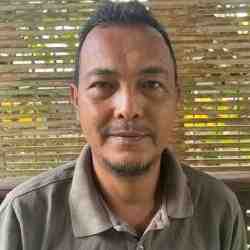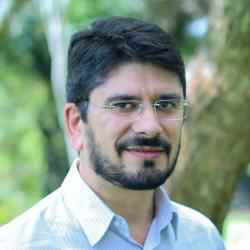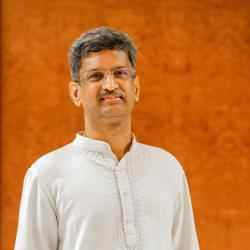前書き
Guilherme Souza has reinvigorated the Brazilian people's relationship with their environment, introducing profitable methods to protect river-based biodiversity and increasing local income through ecotourism and sport fishing.
新しいアイデア
In order to save the Paraíba do Sul River from a declining stock of fish and ecosystems destruction, Guilherme has worked with local citizens to make it the crucial center of their economic livelihood. His program joins local fishermen and community members in fish repopulation, particularly native and endangered species, to restore the environment and engage more people in economic activities in and along the river. Guilherme teaches young people and their families the value of biodiversity and demonstrates that protecting the river and nearby forests will help promote tourism in the form of sport fishing and generate income for fishermen. Guilherme's idea is to change the relationship between people and their habitat, increasing the sustainability and active use, not misuse, of the river's resources.
問題
The Paraíba do Sul River constitutes one of the most important river systems in Brazil. The region drained by the river is approximately 56,000 square kilometers, corresponding to 6 percent of the southeast region of the country. Originating in the state of São Paulo, the river runs over 1,000 kilometers through the states of Minas Gerais and Rio de Janeiro before flowing into the Atlantic Ocean. Since the 1600s, the river basin has suffered aggressive agricultural exploitation and deforestation with each successive economic cycle, the most prominent brought on by coffee growing in the 19th century. Agricultural production, particularly in the region of the headwaters, has led to blockage and extinction of many important tributaries in the river system.
In the last 40 years, a dramatic increase in new river communities and hundreds of industries have put a greater demand on the river as a source of water and energy. The river has been redirected, damned by hydroelectric plants in four locations, and become a source of water for 12 million people, hundreds of industries, and vast expanses of irrigated fields. The river is an important source of livelihood for fishermen who have increasingly been forced to adopt predatory practices like fishing during spawning season and in protected areas to support their families. These practices are carried out in an isolated manner, diminishing fish stocks and destroying biodiversity without regard for the survival and sustainability of the ecosystem as a whole.As the fish decline, the situation for the fishermen becomes more precarious. In the town of Itaocara, located in the interior of the state of Rio de Janeiro, fish provide the principal nutritional and economic resource for hundreds of families. Few alternatives exist for economic activity in the region. The demand for sport fishing by tourists coming from urban centers or abroad is increasing, but a lack of fish stocks and infrastructure to meet the demand is inhibiting communities from benefiting from this potentially lucrative activity.
戦略
Guilherme began his work to recover fish stocks and preserve the environment around the Paraíba do Sul River even before the burgeoning environmental movement had taken hold in the region. He introduced concepts of preservation and sustainability through informal environmental awareness activities in Itaocara and soon learned that the key to preserving the river was to put fishing families at the center of any sustainability or strategic plan. Together with an Itaocara fisherman, Guilherme created the Association of Fishermen and Friends of the Paraíba do Sul River. Through his organization, he implemented the Piabanha Project, named after a type of jumping fish native to the river. Guilherme's objective was to implement a program with four fronts: fish repopulation, environmental education, reforestation, and ecotourism in the area of sport fishing.
Building on years of experience in fisheries, Guilherme turned his technical know-how toward preserving biodiversity and promoting sustainable development along the river. He began with diagnostic studies about the region and river life. He and his team repopulated the Paraíba do Sul River, putting priority on four endangered fish species native to the river. Since 1997, the project has introduced well over one million fish to the river along six municipalities. An added benefit of this program is that the fishermen become directly involved in the reproduction of fish, taking an active interest in the possibility of generating new income for their families for the future.
The program also involves mapping the movements and migrations of the fish, made possible by a low-cost tagging technology Guilherme created. Parallel to these central activities, Guilherme has also launched a campaign to promote responsible fishing, which includes a reporting hotline for fisherman to call after catching a tagged fish, and citing the fish's number and location before throwing it back. This mapping is designed to understand fish movement patterns to help prioritize areas for preservation and reforestation along the river banks.
To complement the repopulation program, Guilherme is developing an environmental education project for schoolchildren, teachers, and fishermen. Students learn about native fish species and their important role in maintaining the biodiversity of the region. They also participate in the big fish release, a popular community event. Guilherme's work has also led to the installation of aquariums in six towns to bring people closer to the fish and help them to recognize native species. In addition, Guilherme has launched a lecture series in 15 schools on the Paraíba do Sul River system and developed teacher orientation workshops to help them incorporate environmental messages into their curricula.
The education program is also directed at the fishing families. Guilherme advises fishermen on the legal size and quantity of captured fish and the importance of not fishing during spawning. To guarantee an incentive for fishermen to abide by the restrictions, the project revolves around a well-structured registration initiative that promotes the fisherman as professionals. Thus far, 600 small-scale fishermen have been registered in Itaocara and six surrounding municipalities, enabling them to receive unemployment benefits from the government during the inactive spawning season. The fisherman thereby maintain an income while preserving stocks of fish for better and more sustainable captures during the high season.
The third component of the Piabanha program involves rehabilitation of the degraded land around the river banks by promoting reforestation with native species. Guilherme has an agreement with the city government of a riverside town to use its greenhouse and nursery for community members to grow and plant saplings in high priority regions. These regions include areas with scarce coverage, buffer zones for larger forest pieces, and areas that the fish tracking system has determined as feeding and reproduction sights.
The fourth project creates clear income generation alternatives for fishermen to revitalize the economy of the river communities in balance with the environment. Guilherme recognizes sport fishing as a potentially nonpolluting activity that is instructive, in high demand, and respectful to biodiversity. Sport fishing, which follows the practice of catching and releasing fish, employs many men and women from riverside communities for services to tourists and river operations. Guilherme signed agreements with the Brazilian Institute of the Environment and the Brazilian Tourism Company to conduct training courses for local fishermen in tourism-based sport fishing. Typically, a fisherman earns 25 Brazilian reais when selling five dourado, or gilt-head fish, on the market. A fisherman trained as a guide, taking two tourists out on a catch-and-release fishing excursion can make 120 Brazilian reais. The tourists take photos with their catches and are allowed to keep a limited number of fish, releasing the rest to continue to reproduce. Tourists coming to the region also spend money on secondary activities, providing income for other businesses like restaurants and inns.
Guilherme currently works out of two Piabanha Municipal Centers in Itaocara and Santo Antonio de Padua. He plans to establish centers along the rivers of six other nearby municipalities with which he has already established accords. These centers will serve as bases for promoting environmental education, organization, and training of fishermen and fish repopulation. They will also help build new, mutually beneficial relationships between the inhabitants of river communities and their natural surroundings.
人
Guilherme was born and raised in Rio de Janeiro and spent much of his youth in parks and biological reserves in and around the bustling city. He was surprised that, despite the parks' proximity, few people took advantage of or appreciated these natural beauties. In 1992, after graduating from university with a degree in biology, Guilherme left Rio de Janeiro to run a fishery on a farm in Itaocara. He spent six years artificially reproducing fish for sale. During this time, he observed the importance of the Paraíba do Sul River but was shocked at the complete lack of protection or management of this vital resource. Fish stocks were decreasing and pollution and degradation increasing. When a fish festival attracted sport fishermen to the town, Guilherme saw the great potential for tourism in the region. Conversely, he thought it absurd that the fishing contest was held during spawning season, the time when the fish were technically protected by law to ensure their reproduction.
Guilherme started to work with people in the community, trying to convince fishermen to alter fishing patterns that were endangering the environment and their own livelihood. Using his expertise in breeding and preservation, Guilherme convinced a local fishing champion to help increase the diversity and challenge of fishing in exchange for a commitment to promote the release of captured fish. As part of this innovation, he encouraged fish capture-and-release days as local celebrations, soon becoming popular events for young and old alike. Building on these early successes, Guilherme has continued to promote a closer and healthier relationship between the people and their environment, successfully turning threats to biodiversity into assets.




